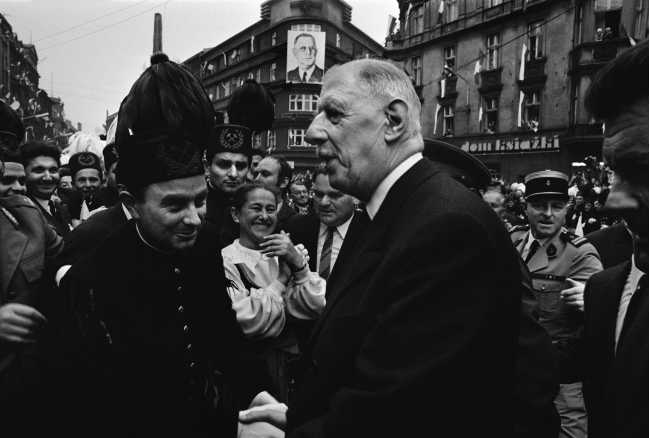France’s rapid shift in the next few years was all the more spectacular in view of the foregoing. Although his Western objectives remained unchanged, by 1964 the search for a new model in East-West relations had become the keystone of the Gaullist international strategy. His goal now was to overcome the Cold War status quo. This change may be explained by three factors. First, the state of East-West relations after the Cuban missile showdown: if the crisis had confirmed the risk of nuclear confrontation, it also heralded, in de Gaulle’s view, a new phase of Soviet-American rapprochement that could strengthen the superpowers’ shared control over Europe. In this respect, in the immediate aftermath of the crisis, French diplomacy was highly wary of the strategic dialogue between Moscow and Washington and, in particular, of the Limited Nuclear Test-Ban Treaty of August 1963, which was seen as portending a Soviet-American condominium. De Gaulle’s shift toward an active East-West policy, in other words, was a response to the challenge of a bipolar international system. If Europe was to be spared a “new Yalta,” France had to take the lead in the quest for detente in Europe and, indeed, for a European detente.
Developments in the east of Europe constituted a second important factor influencing de Gaulle. The fall of Khrushchev in 1964 marked the end of a period of “adventurism” and appeared to set the stage for more predictable

11. De GauUe wanted to defuse East-West tensions and nurture ties with Eastern Europe; here he is seen visiting the Polish city of Gdarisk in 1967.
And reasonable Soviet behavior in the international arena. This was all the more likely, in de Gaulle’s view, because the Sino-Soviet rift was growing and would, in all probability, encourage Soviet moderation toward the West. Moreover, Moscow’s satellites in Eastern Europe were beginning to show more autonomy, as illustrated by the more independent course of Nicolae Ceausjescu’s Romania. In brief, by the mid-1960s, de Gaulle realized that there was a serious chance to inject fluidity into the Eastern European status quo, and he was intent on seizing the opportunity.
Last but not least, the shifting dynamics in the Western alliance also played a role in de Gaulle’s evolving policies. In May 1963, the German Bundestag voted for an Atlanticist preamble to the treaty that de Gaulle and Adenauer had signed at the Elysee palace inJanuary 1963. This, combined with Washington’s pressure on European allies to set up a US-led multilateral nuclear force (MLF), was a clear illustration that Washington, while engaging in strategic rapprochement with Moscow, was also determined to block de Gaulle’s design for a more "European" Europe and to insist on US primacy in the Western alliance, especially after Adenauer left office in West Germany. De Gaulle wanted to counter this trend and thought he could do so, thanks to the development of his relations with the East. For de Gaulle, an active policy of detente, in other words, was also an antidote to US hegemony: hence his determination, from 1963 onwards, to step up France’s politique d I’Est.
In de Gaulle’s view, change in East-West relations required, first of all, the intensification of concrete exchanges, especially in the economic, scientific, technological, and cultural domains. Starting in early 1964, French diplomacy began to increase contacts with Moscow with a view to enhancing bilateral cooperation. This pattern was highlighted by de Gaulle’s spectacular visit to the USSR in June 1966. Because of the warm welcome staged by the Soviets, the trip arguably marked the apogee of the Gaullist politique d I’Est. While seeking not to antagonize Moscow in Eastern Europe, the French president also tried to increase contacts with satellite countries, especially those with historic ties to France like Poland and Romania, where de Gaulle also made high-profile visits in September 1967 and May 1968. Although in the mid-1960s Gaullist France was not alone in advocating the intensification of concrete East-West ties - Bonn had begun to cultivate economic contacts in Eastern Europe as early as 1963 and US president Lyndon B. Johnson had famously declared the need for building bridges with the East in 1964 - France remained in the lead. Washington, in fact, kept a back seat until Johnson’s landmark New York speech in September 1966, and Bonn remained hostage to the Hallstein Doctrine until the new government of the Grand Coalition came into office in December of that year. For a while, French diplomacy was thus in a position to set the East-West agenda in Europe, and it clearly played a role in the evolution of its Western allies’ more active East-West policies. Bonn’s nascent Ostpolitik and Washington’s careful search for detente with Moscow were a response to de Gaulle’s activism.
Yet beyond the intensification of France’s politique d I’Est, de Gaulle’s East-West challenge was of a broader, fundamentally political nature. Starting in 1964, he began to spell out a road map - no longer an abstract vision - of how to effectively overcome the Cold War. He did so most famously in his press conference of February 4, 1965, held exactly twenty years after the Yalta conference, which of course was no accident.246 De Gaulle’s reasoning was as follows: two decades of East-West confrontation in Europe had led to a dead end exemplified by the division of Germany and it could not be overcome short of all-out war. Therefore, the stalemate could be ended only by calling into question the very logic of blocs. This required the USSR’s transformation into a cooperative power and the gradual emancipation of its East European satellites, as well as the emergence of Western Europe as an autonomous political entity with redefined ties to the United States. This dialectical process would progressively establish new patterns of continental cooperation that could eventually lead to a pan-European settlement with, at its core, a reunified Germany - an outcome which de Gaulle had described as early as 1959 as "the natural destiny of the German people."247 While this would be a long-term process - it would take "a generation," he prophesied - and would require preconditions such as Germany’s definitive recognition of its borders and renunciation of nuclear weapons, de Gaulle nonetheless placed the settlement of the German question at the top of the international agenda at a time when the confirmation of the European status quo seemed to freeze it durably. De Gaulle’s concept of detente, in sum, was not just about the relaxation of tensions between the two halves of the divided continent: it was about the progressive healing of East-West relations and constituted a radical departure from the Cold War system, an ambition which his motto "detente, entente, and cooperation" was meant to underscore.




 World History
World History









